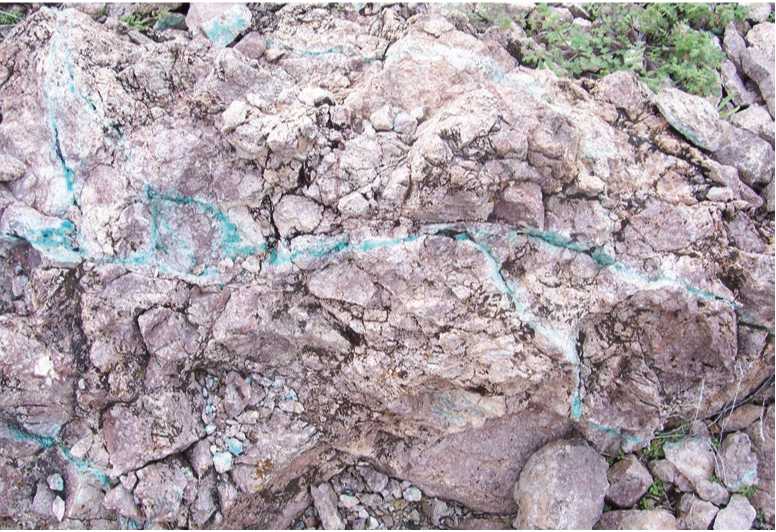The change that begins to sweep across Mesopotamia around 5000 BCE was accelerated by the advent of copper. But since it was mined in remote mountainous areas, the agricultural zones of Mesopotamia stood in an asymmetrical relationship with metal. This means that we have to balance the story of the rise of Mesopotamian cities with that of the rise of metal cultures. The interrelationship between rivers and mountains had begun to develop in the wake of the obsidian trade, but mining, with its divisions of labor and need for territorial control, was not going to put food on the table without trade. Copper, gold, and silver were easy to transport down into the valleys (Figure 8.28). Getting food supplies back up hill was another matter.

Figure 8.28: Copper vein. Source: © Kirk Kittel (http:// creativecommons. org/licenses/ by-sa/3.0/deed. en)
Mining ore and fabricating metal objects were, however, not always done at the same site. In the second century bce, the Celts in Europe and England, who were metallurgical specialists, created ingots, roughed out in the shape of swords, that they used as a type of currency with the Romans in exchange for wine and other items. Similarly, the Mycenaeans at Pylos in the late second millennium bce were known as a metallurgical center, but all the ore had to be imported. All in all, however, during the fourth millennium bce, the almost simultaneous opening of mines in Anatolia, Armenia, Iran, the Sinai, Romania, and the Ural Mountains had an enormous impact on the economic and cultural geography of Mesopotamia and Eurasia. It was a “modernity” all unto its own, with enormous ripple effects across both space and time. One of the earliest written documentations of metal playing a role in international relations dates to around 2350 bce when Sargon of Akkad invaded Anatolia from his lowland base to secure trade routes. In his records, he boasts that a single caravan carried about twelve tons of tin, which could make 125 tons of bronze, enough to equip a large army.
Although we often think of the Tigris and Euphrates region as the birthplace of urban civilization, the truth is that civilization—if we can use that complex and awkward word, at least in this area—was the product of two separate cultures, one a “civilization” moving toward an urban culture and the other a more traditional, village-based society. The raising of grain and the production of metals were mutually reinforcing activities. However, if the production of grain eventually required a centralization of power, this was not the case with metal, which worked best in the smaller context of village life.
Although copper could be made into daggers, its importance, initially at least, lay not in the realm of the military. That only happened later with the development of bronze, which was a stronger metal. The value of copper in the first millennia of its introduction was largely symbolic. It was not an indicator of wealth, which was probably measured primarily in cattle, but of status and thus came in the form of ceremonial daggers and axes, necklaces, hair ornaments, clips, and pins. And we should also remind ourselves that it was associated with magical qualities. What ochre was to First Society people, gold and copper were to the agricultural elites. It was shiny and reflective, and, just as importantly, the product of a mysterious transformation from rock to fluid to solid. This, of course, required an elaborate chain of labor from extraction and transportation to manufacture, the efforts of which were certainly much valued and protected. Furthermore, unlike ochre, which was shared by all, gold was a possession that could be lost or stolen. The safest place was on the body of its owner. If the agricultural world was drifting toward greater hierarchy in order to guarantee surpluses and trade, metal mandated this absolutely.
One of the first places to develop copper production was Qatal Hoyuk. Metsamor in Armenia was also fast becoming an important metal-producing center. Byblos on the Mediterranean was a newly founded port with access to the emerging Dimini culture in Greece, the Trypilian culture in the Ukraine, and the vibrant Vinca culture in the Balkans, all of which were metal exporters. A slag-heap in the Sinai desert, Wadi Nasib, has been estimated to contain 100,000 tons of dross that between around 2500 and 1200 bce could yield about 5,500 tons of copper.23 But that is a drop in the bucket compared to mines in the Alps that might have yielded 17 tons during that same period. In Varna, on the Black Sea coast of Bulgaria, a cemetery dating to about 4000 bc produced no less than 6 kilograms of gold and even larger quantities of copper, all deposited in a display of conspicuous consumption with the elite dead.24 The Taurus Mountains in eastern Anatolia were especially important because of tin. Although there were many copper-producing areas, tin was rare and it was needed in the production of bronze. At an ancient tin mine at a site named Goltepe/Kestel, miners, using narrow shafts, brought cassiterite ore to the surface, where it was crushed, washed, and smelted with charcoal in small crucibles rather than the large furnaces characteristic of copper smelting sites. By measuring the enormous deposits of slag (600,000 tons in one pile), researchers have ascertained that this was a major site during much of the Early and Middle Bronze Age.25 Several sites were on the Iranian Plateau. Gobin Tepe was one of these, producing pins, needles, and jewelry for the Mesopotamian city states along with Sialk and Tal-I Iblis, the latter over a thousand kilometers from Mesopotamia.26 The impact of mining on ecology was formidable. In many places, mining was responsible for the vast deforestation of Ethiopia, Anatolia, and Mesopotamia, which in turn played a part in the desertification of Western Asia.




 World History
World History









